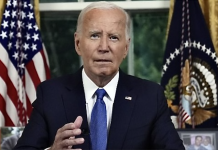
April 15 (UPI) — President Joe Biden announced Wednesday he will withdraw all U.S. troops from Afghanistan by Sept. 11, a plan that NATO’s 30-member states agreed to following a meeting with U.S. military and foreign relations leaders.
Biden formally spoke on the decision one day after media outlets reported on his plans, saying “it is time to end America’s longest war.”
“We cannot continue the cycle of extending or expanding our military presence in Afghanistan, hoping to create the ideal conditions for our withdrawal, expecting a different result,” he said in remarks from the White House Treaty Room.
“I am now the fourth American president to preside over an American troop presence in Afghanistan. I will not pass this responsibility to a fifth.”
The Sept. 11 deadline marks the 20th anniversary of the Sept. 11, 2001, terror attacks that precipitated the war in Afghanistan. Senior administration officials said Tuesday it’s possible all U.S. troops could be out of the country before then.
Biden’s deadline extends the May 2021 deadline previously set by the Trump administration to remove the estimated 2,500 troops from Afghanistan.
NATO said in a statement that in light of no military solutions remaining to the challenges in the war-torn country, Resolute Support Mission forces would start withdrawing May 1, stating the procedure “will be orderly, coordinated and deliberate” and be completed within a few months.
“Withdrawing our troops does not mean ending our relationship with Afghanistan. Rather, this will be the start of a new chapter,” NATO said, warning the Taliban that any attacks targeting allied troops during this withdrawal “will be met with a forceful response.”
Along with U.S. troops, NATO has a force of more than 9,500 men from 36 contributing nations in Afghanistan, which it said Wednesday was “one of the largest coalitions in history” assembled in service of the Middle Eastern country.
The decision by NATO followed a meeting with Defense Secretary Lloyd Austin III and Secretary of State Antony Blinken, after which NATO Secretary General Jen Stoltenberg described the mission to reporters as a success, stating they have prevented Afghanistan from serving as a safe haven for terrorist attacks against ally nations.
“We went into Afghanistan together, we have adjusted our posture together and we are united in leaving together,” he said, adding “it’s now for the Afghan people to build a sustainable peace that puts an end to violence.”
Blinken said the goals they had set out at the start of the two-decade war had been achieved while Austin, who said he “fully” supports the withdrawal, told reporters that today the Afghan people own their own country but violence still persists and this is not mean the end of their relationship with the United States
“We will look to continue funding key capabilities such as the Afghan air force and special mission wing, and we will seek to continue paying salaries for Afghan security forces,” he said during an appearance at NATO headquarters in Brussels.
After his remarks Wednesday, Biden visited Section 60 of Arlington National Cemetery, the location where many troops killed in Afghanistan are buried.
“I’m always amazed at generation after generation, women and men who are prepared to give their lives for their country,” Biden told reporters at the cemetery.
Sen. Lindsey Graham, R-S.C., reiterated his opposition to a full withdrawal Wednesday.
“With all due respect to President Biden, you have not ended the war, you’ve extended it,” he said during a news conference on Capitol Hill. “You have made it bigger, not smaller.”
Sen. Liz Cheney, R-Wyo., also disagreed with the decision, saying that announcing a timeline puts American troops at risk of an attack.
“Now I’m not sure why the White House has selected [Sept. 11], but I can tell you that that is a huge victory, a huge propaganda victory for the Taliban, for al-Qaida,” she told reporters. “The notion that on the day that they attacked us, we are going to mark that anniversary by withdrawing our forces?”





